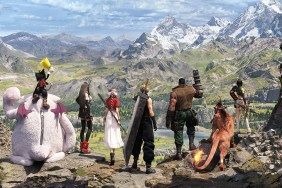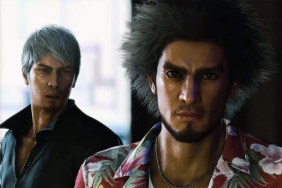My Fang strikes like Lightning in the Snow. Or something.
Oh, Final Fantasy, what a tumultuous mistress you are. You tease and and titillate new releases with your gorgeous visuals and promises of revolutionizing RPGs, but with every incarnation you both giveth and taketh away.
[image1]Final Fantasy XIII has a lot riding on its shoulders. Between being the first entry in the series on the current (seventh) generation of consoles and following the punch-to-the-gut that some fans consider FFXII to be, it’s hard to imagine a game that can deliver on such lofty expectations. And the series has become so hallowed that I doubt any new entry really could. Perhaps that’s the very reason Square has taken the series in such radically different directions — maybe if we stop getting anything that rubs our nostalgia bone and reminds us of the sunny, green pastures of the RPGs of decades past, we’ll stop expecting it.
The plot and characters shine brightest in FFXIII, which is a very welcome relief after the generic, cookie-cutter experience of FFXII. Lightning and Snow lead a colorful cast of characters (none of the others are named after meteorological phenomena, surprisingly enough). A lot of cut-scene time is spent on character development, and Square has admirably and impressively spread that development equally among the six protagonists. Everyone has an interesting and somewhat tragic backstory, from the young and inexperienced Hope to the sassy and sexually ambiguous Fang, to the “token black guy” Sazh. (No, really, other than Sazh and his son, I didn’t spot a single other black person in the game. But hey, at least it’s progress!)
What really makes the characters so engaging (and dare I say more so than any Final Fantasy to date), is the powerful tension between the characters, not just between them and their opposition. Not only is the party on the run from the entire world while trying to change their grim fate, but everyone also has a significant issue with at least someone else in the party. These internal issues range from simple mistrust and disapproval to actual murderous intent. Watching the characters overcome their personal problems with each other is just as satisfying as witnessing the far-reaching plot unfold. Props to the voice actors who all do an amazing job bringing the emotion to the fore.
Lightning and company come from the world of Cocoon, which is actually encased in a gigantic metal sphere and hovers in the sky above the much bigger world of Pulse. Cocoon and Pulse are both run by Fal’cie, an incredibly powerful race of robot-things, and the Fal’cie of both worlds tend to be in opposition to the other. The humans of Cocoon live alongside their mechanical matrons like sheep, convinced through propaganda and fear that the world below is evil and tainted. Some fans may be disappointed that all remaining shreds of a medieval setting have been thrown away in favor of a full-on sci-fi extravaganza, but it’s damn well-crafted. Asimov would be proud.
[image2]The party, through a combination of coincidence and feigned coincidence, is thrown together and forced all at once to become L’Cie, humans chosen by a Fal’cie to complete a “Focus”. L’Cie who succeed in their mission are frozen in crystal, and those who fail turn into wandering monsters. It’s kind of like playing the showcase showdown in The Price is Right, if both showcases offered that crappy dinette set and a vacuum cleaner. To make things worse, their focus seems to be the utter destruction of Cocoon, which is not exactly an appealing task. But like any good RPG heroes, they decide there must be… another way!
And boy howdy, do they sure take their sweet time finding it. This is easily the longest entry in the series, and a serious rival with MGS4 for the most cut-scenes ever. Even if you’re an insanely fast player, expect to take 40 hours to finish this monster of an RPG. If you’re more of the deliberate explorer breed of gamer, 50-60 hours for your first playthrough is not an unreasonable estimate. I mean, when you’re seven hours in and you’re still getting battle tutorials, you know you’d better settle in for the long haul.
Unfortunately, most of that time is spent in the incredibly linear first two-thirds of the game. You will literally run along a straight line for most of the game, deviating ever so slightly to pick up a treasure in a cubbyhole or alleyway if you so choose. You just run from cutscene to cutscene, fighting a battle or two on the way. Once you reach chapter 11 (out of 13), the environments open up a bit more and you can explore in true FF style with side missions to boot, but it feels "too little, too late". It’s somewhat baffling that the game was designed this way.
The battle system is another clear departure from tradition. FFXIII utilizes an odd mashup of the real-time battles of FFXII and the ATB system from the bulk of previous FFs. The ATB this time around, however, fills in multiple segments at a time, and allows you to unleash a flurry of attacks or spells at once. This, combined with “staggering” an enemy by stringing enough hits together – enabling you to launch it up in the air and juggle it – makes the battles feel like they’re almost out of a combo-oriented fighting game.
[image3]You only control your party leader, though, and the other party members are handled through A.I.. While this seems restrictive, you’re given control of the party through Paradigms. There are six “roles” (otherwise known as "jobs" for the FF-initiated), which range from the offensive Commando, to the healing Medic, to the enemy-debuffing Saboteur. Paradigms are preset combinations of these roles which you can switch quickly and limitlessly on the fly depending on the situation. If an enemy is gearing up for a big attack, you should go into a defensive Paradigm to tough it out. Once you’ve staggered them, it’s time to switch to three heavy-hitters.
Until you advance your roles far enough, battles may seem boring and one-dimensional. You’ll probably make it through most of your battles using just a straight offensive Paradigm. But after you’ve developed and learned more skills, the game ramps up the difficulty proportionally and you’ll have to start switching those Paradigms around faster than a grifter playing Three-Card Monte. By the last few chapters, the fights get incredibly challenging and it won’t be uncommon to skip packs that you simply cannot kill, or die over and over on a boss until you get the timing of its attacks and your Paradigm shifts down perfectly.
Character advancement occurs by way of the Crystarium, FFXIII‘s kinda-sorta cousin to the Sphere Grid of FFX. But instead of having one huge grid with every ability on it, the Crystarium’s setup is unique to each character, and it’s further split up by that character’s roles. You also don’t move along by dropping a single sphere down on the next spot, but rather by pumping your accumulated CP into the next upgrade. It’s a good system overall (and a hell of a lot better than the License Board of FFXII), but it takes a lot longer than it should to navigate the Crystarium, which requires you to keep switching from role to role and character to character to decide just where to spend your CP.
If you’ve seen a single screenshot or video of Final Fantasy XIII, then you already know how beautiful it is. I hardly need to gush about the graphics. If anyone out there still remembers the heap of chocobo dung that is Final Fantasy: The Spirits Within, well, the actual gameplay in FFXIII looks better than that whole movie. And of course it goes without saying that the cut-scenes look even better than that. Do yourself a favor and play it on an HDTV, any way you can. It would truly be a travesty to play it on SD.
There will be a decent number of people out there disappointed with FFXIII. I don’t think Square cares one bit, to be honest, and after playing it, neither do I. It looks different, feels different, and plays different from any other FF, but it’s still a good ride. The shock of change is overwhelming at first, but give the game enough time to develop and you’ll soon appreciate its intricacies. A few problematic design choices aside, there’s a lot of fun to be had in this newest and most Final-est of Fantasies.
-
It's so pretty
-
Great plot and setting
-
Evenly well-developed characters
-
Combat gets more strategic and challenging
-
...but it's one-dimensional most of the time
-
Extremely lengthy, mostly cut-scenes
-
Extremely linear until almost the end











